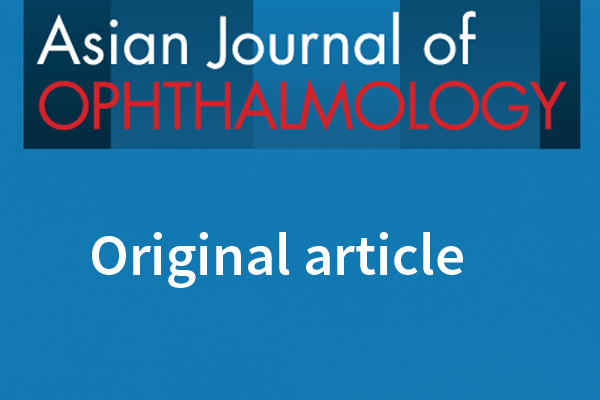Fuchs endothelial corneal dystrophy and small eyes
Abstract
Aim: To determine whether there is an association between Fuchs endothelial corneal dystrophy (FECD) and shorter axial length (AL), shallower anterior chamber depth (ACD) and higher spherical equivalent (SE). In addition, to evaluate whether there is a correlation between AL and severity of corneal decompensation in FECD, using corneal thickness as a proxy.
Design: Retrospective cohort study.
Methods: This was a single-centre study conducted in a cornea clinic in Sydney, Australia. Detailed clinical measurements of 91 eyes of 50 FECD patients were compared with 110 eyes of 55 controls. Main outcome measures included AL, ACD and SE. Other outcome measures included central corneal thickness, visual acuity, intraocular pressure and keratometry.
Results: Mean AL of FECD patients was 23.6 mm (standard deviation [SD] ±0.9 mm), compared with 24.7 mm (SD ±1.8 mm) for controls (1.1 mm difference [95% confidence interval [CI] 0.5-1.6], p < 0.001, independent sample t-test); corresponding means for ACD were 3.0 and 3.3 mm (0.32 mm difference [95%CI 0.2-0.5], p < 0.001, independent t-test). Eleven out of the 22 FECD patients with available refraction data had hypermetropic refraction compared with 16 out of 36 controls (p = 0.68, chi-squared test). The mean SE of FECD patients (+0.10D) was higher than controls (−1.33D) (1.4D difference [0.1-2.8], p = 0.04, independent t-test). No statistically significant correlation was found between AL and corneal thickness (p = 0.28, linear regression).
Conclusion: In this retrospective cohort study, a strong association was established between FECD and small eyes, with shorter AL and shallower ACD, compared with controls. These results have important implications for surgical planning, as shorter AL and ACD in FECD patients likely contribute to their high risk of corneal decompensation following cataract surgery.
References
Park CY, Lee JK, Gore PK, Lim CY, Chuck RS. Keratoplasty in the United States: a 10-year review from 2005 through 2014. Ophthalmology. 2015;122(12):2432-2442. doi: 10.1016/j.ophtha.2015.08.017.
De Sanctis U, Alovisi C, Bauchiero L, et al. Changing trends in corneal graft surgery: a ten-year review. Int J Ophthalmol. 2016;9(1):48-52. doi: 10.18240/ijo.2016.01.08.
Elhalis H, Azizi B, Jurkunas UV. Fuchs endothelial corneal dystrophy. Ocul Surf. 2010;8(4):173-184.
Pitts JF, Jay JL. The association of Fuch’s corneal endothelial dystrophy with axial hypermetropia, shallow anterior chamber, and angle closure glaucoma. Br J Ophthalmol. 1990;74:601-604.
Lowenstein A, Geyer O, Hourvitz D, Lazar M. The association of Fuchs corneal endothelial dystrophy with angle closure glaucoma. [Letter to Ed] Br J Ophthalmol. 1991;75(8):510.
Shen P, Zheng Y, Ding X, et al. Biometric measurements in highly myopic eyes. J Cataract Refract Surg. 2013;39(2):180-187. doi: 10.1016/j.jcrs.2012.08.064.
Sahin A, Hamrah P. Clinically relevant biometry. Curr Opin Ophthalmol. 2012;23(1):47-53. doi: 10.1097/ICU.0b013e32834cd63e.
Nakhli FR. Comparison of optical biometry and applanation ultrasound measurements of the axial length of the eye. Saudi J Ophthalmol. 2014;28(4):287-291. doi: 10.1016/j.sjopt.2014.04.003.
Hwang HB, Lyu B, Yim HB, Lee NY. Endothelial cell loss after phacoemulsification according to different anterior chamber depths. J Ophthalmol. 2015;2015:21076. doi: 10.1155/2015/210716.
Walkow T, Anders N, Klebe S. Endothelial cell loss after phacoemulsification: relation to preoperative and intraoperative parameters. J Cataract Refract Surg. 2000;26(5):727-732.
Samarawickrama C, Wang JJ, Burlutsky G, Tan AG, Mitchell P. Nuclear cataract and myopic shift in refraction. Am J Ophthalmol. 2007;144(3):457-459.
De Bernardo M, Zeppa L, Forte R, et al. Can we use the fellow eye biometric data to predict IOL power? Semin in Ophthalmol. 2017;32(3):363-370. doi: 10.3109/08820538.2015.1096400.
Covert DJ, Henry CR, Koenig SB. Intraocular lens power selection in the second eye of patients undergoing bilateral, sequential cataract extraction. Ophthalmology. 2010;117:49-54. doi: 10.1016/j.ophtha.2009.06.020.
Rose K, Smith W, Morgan I, Mitchell P. The increasing prevalence of myopia: implications for Australia. Clin Exp Ophthalmol. 2001;29(3):116-120.
Pan CW, Boey PY, Cheng CY, et al. Myopia, axial length, and age-related cataract: the Singapore Malay eye study. Invest Ophthalmol Vis Sci. 2013;54(7):4498-4502. doi: 10.1167/iovs.13-12271.
Armstrong RA. Statistical guidelines for the analysis of data obtained from one or both eyes. Ophthalmic Physiol Opt. 2013;33(1):7-14. doi: 10.1111/opo.12009.

Copyright (c) 2020 Nicole Shao-Yuen Lim, John Males

This work is licensed under a Creative Commons Attribution 4.0 International License.
Authors who publish with this journal agree to the following terms:
- Authors retain copyright and grant the journal right of first publication, with the work twelve (12) months after publication simultaneously licensed under a Creative Commons Attribution License that allows others to share the work with an acknowledgement of the work's authorship and initial publication in this journal.
- Authors are able to enter into separate, additional contractual arrangements for the non-exclusive distribution of the journal's published version of the work (e.g., post it to an institutional repository or publish it in a book), with an acknowledgement of its initial publication in this journal.
- Authors are permitted and encouraged to post their work online (e.g., in institutional repositories or on their website) prior to and during the submission process, as it can lead to productive exchanges, as well as earlier and greater citation of published work (See The Effect of Open Access).


